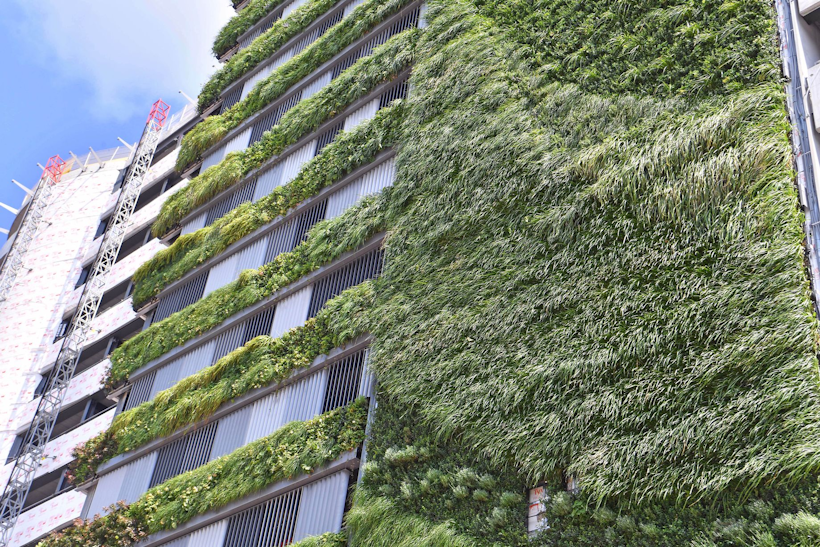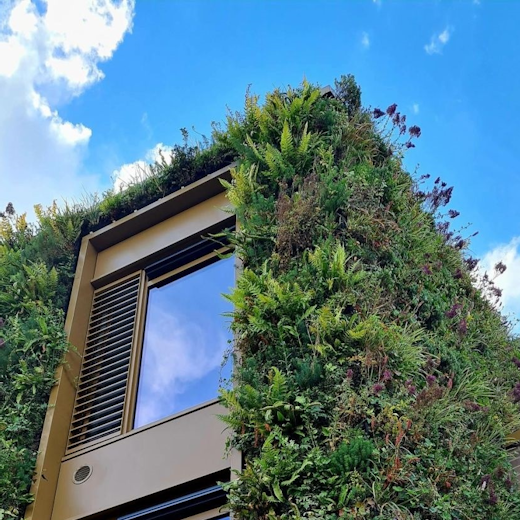Urban areas face a multitude of environmental challenges, including managing stormwater, reducing pollution, and enhancing air quality.
Among innovative solutions, green walls stand out for their multifaceted benefits, particularly in urban water management and quality improvement.
In this blog, we’re going to explore how green walls can address water-related issues in cities and contribute to a healthier urban environment.
Understanding Green Walls
Green walls, also known as vertical gardens or living walls, are structures attached to buildings or standalone installations that support various types of vegetation. These walls can be made from different systems, such as modular panels, hydroponic systems, or felt layers, providing a habitat for plants to grow vertically.

The Water Management Benefits of Green Walls
Stormwater Retention and Management
One of the most significant benefits of green walls is their ability to retain and manage stormwater. Urban areas with extensive concrete surfaces often struggle with runoff during heavy rains, leading to flooding and pollution of water bodies. Green walls help mitigate these issues by:
- Absorbing Rainwater: The vegetation and growing medium in green walls can absorb significant amounts of rainwater, reducing the volume and speed of runoff.
- Delaying Runoff: By retaining water, green walls slow down the flow of runoff, decreasing the likelihood of overwhelming urban drainage systems.
Pollution Filtration
Stormwater runoff in cities often carries pollutants such as heavy metals, oils, and other contaminants. Green walls contribute to improving water quality by:
- Filtering Pollutants: The plants and soil in green walls act as natural filters, trapping and breaking down pollutants before they enter the urban drainage system.
- Phytoremediation: Certain plant species used in green walls can absorb and detoxify harmful substances from the water, further enhancing water quality.
Reduction of Heat Island Effect
Urban areas tend to be warmer than their rural surroundings due to the heat island effect, which can exacerbate water evaporation and stress urban water systems. Green walls help mitigate this by:
- Cooling Effect: Through the process of evapotranspiration, green walls release moisture into the air, which cools the surrounding environment and reduces the demand on urban water supplies.

Green Walls Enhancing Water Quality
Improved Air Quality
Green walls contribute to cleaner air by trapping dust, pollutants, and carbon dioxide, which in turn reduces the amount of these contaminants settling into water bodies. This indirect improvement in water quality is crucial for maintaining healthy urban ecosystems.
Biodiversity Support
By providing a habitat for various plant species and attracting beneficial insects and birds, green walls promote urban biodiversity. This increased biodiversity can enhance the resilience of urban ecosystems, including the natural filtration systems that improve water quality.
Educational and Aesthetic Benefits
Beyond their environmental impact, green walls serve as educational tools, raising awareness about sustainable practices and the importance of water conservation. Their aesthetic appeal also encourages more green infrastructure projects, creating a positive feedback loop for environmental stewardship.

Implementing Green Walls in Urban Areas
To maximise the benefits of green walls for urban water management and quality, cities should consider the following:
- Strategic Placement: Installing green walls in areas prone to flooding or near water bodies can maximise their stormwater management benefits.
- Selecting Appropriate Plants: Using native and drought-resistant plant species ensures that green walls are sustainable and effective in their water management roles.
- Integrating with Other Green Infrastructure: Combining green walls with green roofs, rain gardens, and permeable pavements can create a comprehensive urban water management system.
Living Walls from Viritopia
With over 20 years of experience of designing and maintaining biophilic infrastructure, Viritopia can create a detailed plan of how a scheme will meet regulatory requirements.

Book a Consultation with Viritopia
Green walls offer a practical and visually appealing solution to many urban environmental challenges, particularly in water management and quality improvement.
By absorbing rainwater, filtering pollutants, reducing heat island effects, and supporting biodiversity, green walls can transform urban landscapes into healthier, more resilient environments.
As cities continue to grow and face increasing environmental pressures, the adoption of green walls and other green infrastructure will be essential in creating sustainable urban futures.
With over 20 years of experience of designing and maintaining biophilic infrastructure, Viritopia can create a detailed plan of how a scheme will meet regulatory requirements.
We assist with faster planning process and provide you with what’s needed to elevate your project. Book a living wall consultation with our expert team today or find out more about our green walls and their benefits.

